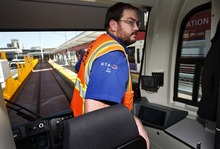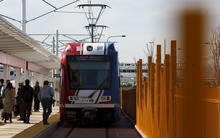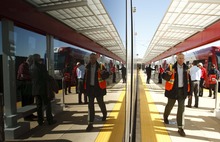This is an archived article that was published on sltrib.com in 2013, and information in the article may be outdated. It is provided only for personal research purposes and may not be reprinted.
The Utah Transit Authority showed off its new TRAX line to Salt Lake City International Airport to the media Wednesday — pointing out features from art projects at each station to 23 colors of power poles (as a "ribbons of color" gateway to the city.) But the spur's big selling point is the convenience it offers travelers.
"You get off the train, walk into our welcome center, go around the corner — and, boom, you are at the JetBlue ticket counter," said Jim Webb, UTA project manager.
The line opens officially Sunday, but the public can ride it for free Saturday from 10 a.m. to 10 p.m. — but is asked to donate a can of food at stations in lieu of paying a fare.
Community celebrations with food and music are scheduled at the five new stops along North Temple — including the Utah State Fair offering music, funnel cakes, face painting, clowns, balloon artists, bounce houses and animals to celebrate its new stop.
An opening ceremony for the line is scheduled at 2 p.m. in a parking lot near the North Temple Bridge Station.
The new six-mile line — which cost $350 million, including $235 million for construction — takes about 20 minutes to travel from downtown Salt Lake City to the airport as part of the green line from West Valley City. Trains will run every 15 minutes on weekdays and every 20 minutes on weekends.
The extension took four years to build, has been undergoing testing for months and is being finished about two months ahead of schedule.
"We are ahead of schedule and under budget," said UTA spokesman Chad Saley.
He notes that riders on the TRAX or FrontRunner commuter systems anywhere on the Wasatch Front will be just one transfer or less away from the airport.
FrontRunner shares a station with the new airport TRAX line at the bridge over railroad tracks at North Temple. The FrontRunner station is beneath the bridge, while the TRAX station is on top of it. The two are connected by an escalator. .
UTA and Salt Lake City replaced the old three-block North Temple viaduct with one that is two blocks long to carry trains and cars. The bridge was closed for 16 months before it reopened last August.
Each station on the new TRAX line has artistic touches ranging from etched glass from Germany at the North Temple Bridge to paintings or sculptures elsewhere. Also, several stations have solar energy panels to generate their own electricity, and all stations use LED lighting to save energy.
Paul O'Brien, UTA rail service manager, says TRAX passengers will notice that the ride along North Temple is straighter and smoother than along, say, 400 South. He says Salt Lake City worked with it to allow that straight run "and less weaving in and out."
As the rails approach the airport — and leave commercial and residential areas — trains reach speeds of 60 mph. In that stretch, UTA is also experimenting with a variety of landscaping to see which may work best in arid climate for future projects.
The new extension is expected to attract 4,500 riders a day at its opening.
Even as the extension is being completed, UTA will begin design work this summer on another short extension of the project that will come in a few years amid airport remodeling.
"That's an enhancement that will go along with the airport reconstruction," said Steve Meyer, UTA chief capital development officer. "It will put you right into the center of the terminal."
Meyer adds that the TRAX line will offer 72 round trips to the airport a day, a vast improvement over the 36 slower buses trips offered previously. However, the new line will not operate early enough to deliver passengers to some early-morning flights — and will close before some late-night arrivals. The problem will be worse on weekends. Still, TRAX will serve the vast majority of flights.
A Salt Lake Tribune review of schedules shows that the first train to run the full length of the green line would be too late for the suggested arrival time for about a dozen weekday flights. The last train would leave too early for about 17 night arrivals.
On Sundays, the first train would be too late for scores of flights, and the last train at night would also be too early for about 60 flights. Saley said UTA budgets currently prevent expanding hours of operation.
The agency warned against travelers planning on using UTA parking lots as free long-term parking. People parked in one of the lots for more than 24 hours could be ticketed or towed.
Charles Henderson, chairman of the UTA Board's Planning and Development Committee, said at a meeting Wednesday that UTA should reconsider that policy now with the new airport line. "I travel by air often, and the trips almost always take longer than 24 hours," he said, adding he — and many others — would like to park long-term to use the airport TRAX.
UTA officials said they are considering a pilot program to allow longer-term parking in select parking lots, perhaps the few where it already charges fees for parking.









